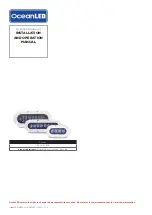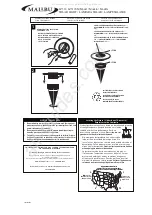
77
2
CHAPTER
TWO
Chapter 2: Installation
Note
: OceanLED makes every effort to protect our marine and fresh water environment as
well as our natural resources. Please take care to keep packaging away from and out of the
water by ensuring loose packaging materials are secured and not susceptible to being blown
into the water. Please recycle all packaging materials as the sustainability of our environment is everyone's
responsibility.
WARNING:
•
Ensure mounting location is flat and check internally for ease of access or if there is a rib, strut, stringer
or other hull irregularity that may interfere with the installation.
•
Never use power tools to secure your lights;
hand tighten only.
•
Light is for mounting directly to a flat surface on the hull, with the cable passing through a 1/2"
(12.5mm) hole in the hull.
Do not submerse your cable in water; cable and connections exposed to
underwater submersion will not be covered by warranty. Mounting the light in any other configuration,
other than those described in this guide, will invalidate its warranty.
•
We recommend you use screws provided. If alternative screws are used, do not use counter sunk or non
flat shoulder screws to secure your lights to the hull.
•
OceanLED lighting products must be dry fitted. When installing, be sure that the light fits the area and
secures to the hull using the appropriate hardware before applying any sealant.
•
There are several different hull types. Most are either solid GRP or cored. Be sure you follow the correct
procedures for the hull you are preparing since all require different preparation methods. We will cover
the most common type below. If in doubt please contact your local OceanLED representative or the
boat manufacturer for assistance.
•
Please check all components prior to installation. If there is any damage to connectors, cables, and/
or any other component, please notify OceanLED BEFORE installation. Failure to notify OceanLED of
damage in transit prior to installation will lead to violation of warranty.
2.1 Preparing a fiberglass hull
TIP:
Always wear safety goggles and a dust mask.
1.
Drill a 3mm / 1/8” pilot hole square to mounting surface from inside the hull if possible. If there is
a rib, strut, or other hull irregularity near the selected mounting location, this will need to be taken
into account in the planning phase and the location adjusted accordingly, or the obstruction safely
removed or modified. If the pilot hole is found to be drilled in the wrong location, drill a second hole
in a better location and repair first pilot hole.
2.
Using a suitable drill, make a 1/2" – 5/8" (12 - 15mm) hole. Ensure the light will fit flush and will be
square to the mounting surface.
3.
Sand the area around the hole using a heavy grit sandpaper to remove the previous bottom paint
and to ensure that the sealant will adhere properly to the hull. If there is any petroleum residue
inside the hull, remove it with acetone before sanding.






































